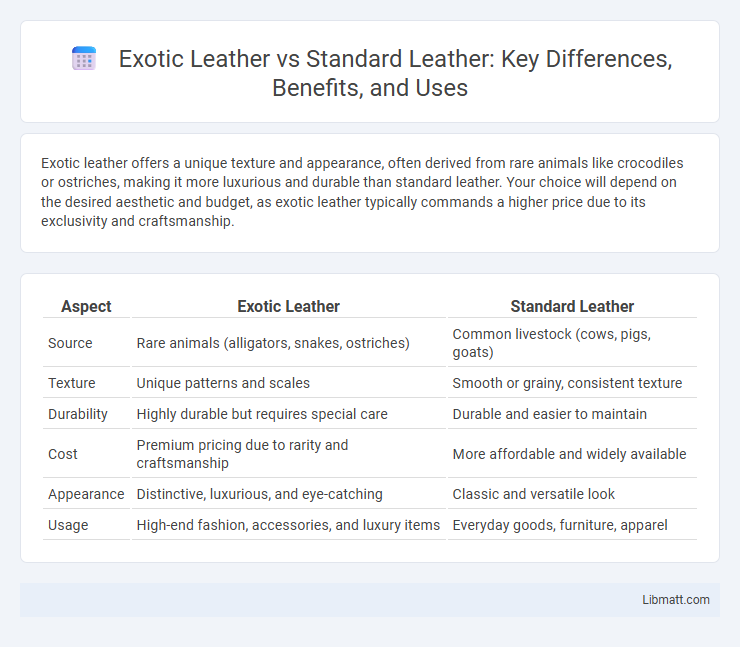Exotic leather offers a unique texture and appearance, often derived from rare animals like crocodiles or ostriches, making it more luxurious and durable than standard leather. Your choice will depend on the desired aesthetic and budget, as exotic leather typically commands a higher price due to its exclusivity and craftsmanship.
Table of Comparison
| Aspect | Exotic Leather | Standard Leather |
|---|---|---|
| Source | Rare animals (alligators, snakes, ostriches) | Common livestock (cows, pigs, goats) |
| Texture | Unique patterns and scales | Smooth or grainy, consistent texture |
| Durability | Highly durable but requires special care | Durable and easier to maintain |
| Cost | Premium pricing due to rarity and craftsmanship | More affordable and widely available |
| Appearance | Distinctive, luxurious, and eye-catching | Classic and versatile look |
| Usage | High-end fashion, accessories, and luxury items | Everyday goods, furniture, apparel |
Introduction to Exotic and Standard Leather
Exotic leather, sourced from unique animals such as alligators, snakes, and ostriches, offers distinct textures and patterns that set it apart from standard leather derived primarily from cowhide. The tanning process for exotic leather often involves specialized techniques to preserve its natural characteristics, enhancing durability and aesthetic appeal. Standard leather, widely used in fashion and upholstery, provides a versatile and cost-effective alternative with more uniform grain and consistent quality.
Defining Exotic Leather: Types and Sources
Exotic leather refers to materials derived from non-traditional animal hides such as alligator, python, ostrich, and stingray, prized for their unique textures and patterns. Unlike standard leather, which typically comes from cows, exotic leather undergoes specialized tanning processes to preserve its distinct natural characteristics. Your choice between exotic and standard leather depends on the desired aesthetic, durability, and exclusivity of the final product.
Standard Leather: Origins and Common Uses
Standard leather, primarily derived from cowhide, is widely used in upholstery, footwear, and fashion accessories due to its durability and versatility. Its tanning processes, often chrome or vegetable tanning, enhance water resistance and texture uniformity, making it suitable for mass production. Common applications include car interiors, belts, jackets, and wallets, reflecting its accessibility and cost-effectiveness compared to exotic leather varieties.
Durability Comparison: Exotic vs Standard Leather
Exotic leather, derived from materials like alligator, ostrich, or snakeskin, generally offers superior durability due to its dense fiber structure and natural resistance to wear and tear compared to standard leather from cowhide. Standard leather, while durable and versatile, may show signs of aging and abrasion more quickly under heavy use or exposure to elements. Your choice depends on the balance between luxury style and the specific durability needs for long-term use.
Visual Appeal and Texture Differences
Exotic leather, such as alligator, ostrich, or python, features unique patterns and textures that offer a visually striking, luxurious appearance compared to the uniform grain of standard cowhide leather. The tactile experience of exotic leather is distinct, often exhibiting raised scales or bumps that provide a rich, multidimensional feel, whereas standard leather tends to be smoother and more consistent. These visual and textural differences make exotic leather highly sought after for high-end fashion and accessories where standout aesthetics are essential.
Ethical and Environmental Considerations
Exotic leather, sourced from animals like snakes, crocodiles, and ostriches, often raises significant ethical concerns due to the impact on wildlife populations and the potential for illegal poaching. Standard leather, typically derived from cattle, involves large-scale livestock farming that contributes to deforestation, greenhouse gas emissions, and water pollution. Both types of leather production face environmental challenges, but standard leather's widespread use means its ecological footprint is generally larger, prompting increased demand for sustainable and ethically sourced alternatives.
Cost Analysis: Exotic Leather vs Standard Leather
Exotic leather, sourced from animals like alligators, snakes, and ostriches, typically commands a significantly higher price than standard leather due to its rarity, intricate tanning processes, and unique texture. Standard leather, derived from cowhide and other common hides, offers a more cost-effective option with consistent quality and widespread availability. Your choice between exotic and standard leather depends on budget considerations and the value placed on exclusivity and distinctive aesthetics.
Maintenance and Care Requirements
Exotic leather, such as alligator or ostrich, demands specialized maintenance including regular conditioning with specific products to prevent drying and cracking, unlike standard leather which typically requires basic cleaning and occasional conditioning. Your care routine for exotic leather must also avoid exposure to direct sunlight and moisture, as these elements can cause significant damage, whereas standard leather is generally more forgiving under normal use conditions. Proper storage in a cool, dry place preserves the integrity of exotic leather, ensuring its longevity and luxurious appearance.
Popular Applications in Fashion and Industry
Exotic leather, such as alligator, python, and ostrich, is highly sought after in luxury fashion for high-end handbags, shoes, and watch straps due to its unique texture and exclusivity. Standard leather, primarily cowhide, dominates the mass market in clothing, upholstery, and automotive interiors, offering durability and affordability. Both types serve specialized purposes: exotic leather enhances premium product appeal, while standard leather supports widespread industrial and fashion applications.
Choosing the Right Leather: Factors to Consider
When choosing between exotic leather and standard leather, consider durability, texture, and aesthetic appeal based on the intended use and lifestyle. Exotic leathers, such as crocodile or ostrich, offer unique patterns and a luxury feel but require specialized care and higher investment compared to standard cowhide leather. Weight, resistance to wear, and ethical sourcing are essential factors that influence the selection for both fashion and functional applications.
Exotic leather vs standard leather Infographic

 libmatt.com
libmatt.com